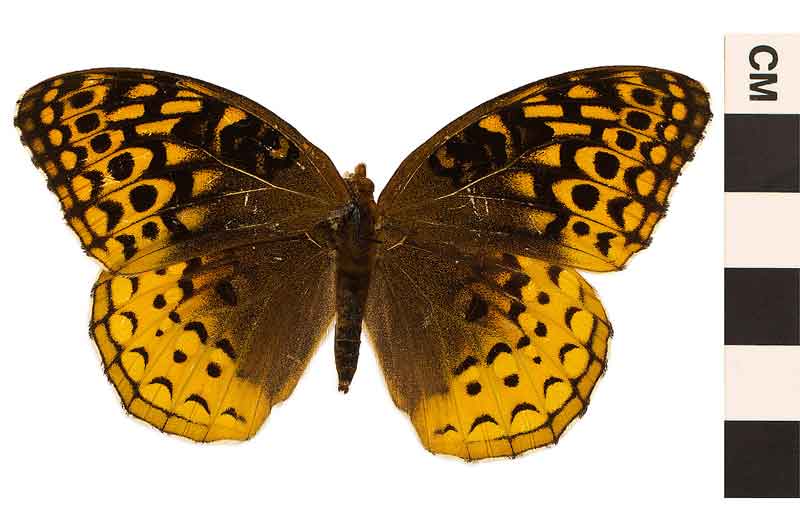
Speyeria cybele
Superregnum: Eukaryota
Cladus: Unikonta
Cladus: Opisthokonta
Cladus: Holozoa
Regnum: Animalia
Subregnum: Eumetazoa
Cladus: Bilateria
Cladus: Nephrozoa
Cladus: Protostomia
Cladus: Ecdysozoa
Cladus: Panarthropoda
Phylum: Arthropoda
Subphylum: Hexapoda
Classis: Insecta
Cladus: Dicondylia
Subclassis: Pterygota
Cladus: Metapterygota
Infraclassis: Neoptera
Cladus: Eumetabola
Cladus: Endopterygota
Superordo: Panorpida
Cladus: Amphiesmenoptera
Ordo: Lepidoptera
Subordo: Glossata
Cladus: Coelolepida
Cladus: Myoglossata
Cladus: Neolepidoptera
Infraordo: Heteroneura
Cladus: Eulepidoptera
Cladus: Ditrysia
Cladus: Apoditrysia
Cladus: Obtectomera
Superfamilia: Papilionoidea
Familia: Nymphalidae
Subfamilia: Heliconiinae
Tribus: Argynnini
Genus: Speyeria
Species: Speyeria cybele
Subspecies: S. c. carpenteri – S. c. charlottii – S. c. cybele – S. c. eileenae – S. c. krautwurmi – S. c. leto – S. c. letona – S. c. novascotiae – S. c. pseudocarpenteri – S. c. pugetensis
Name
Speyeria cybele (Fabricius, 1775)
Type locality: USA, Virginia, James City County, Jamestown.
Neotype: BNHM. male ♂.
Synonyms
Papilio Nymphalis Phaleratus cybele Fabricius, 1775 (original combination)
Argynnis cybele (Fabricius, 1775)
Speyeria cybele (Fabricius, 1775): Passos and Grey, 1945
Papilio Nymphalis Phaleratus Daphnis Cramer, 1775
Argynnis cybele ab. baal Strecker, 1878
References
Additional references
Campbell, E.O., Gage, E.V., Gage, R.V. & Sperling, F.A.H. 2020. Single nucleotide polymorphism‐based species phylogeny of greater fritillary butterflies (Lepidoptera: Nymphalidae: Speyeria) demonstrates widespread mitonuclear discordance. Systematic Entomology 45(2): 269–280. DOI: 10.1111/syen.12393 Reference page.
dos Passos, C.F. & Grey, L.P. 1945. Systematic catalog of Speyeria (Lepidoptera, Nymphalidae) with designations of types and fixations of type localities. American Museum Novitates 1297: 1–30. Reference page.
Dunford, J. C. 2009. Taxonomic overview of the greater fritillary genus Speyeria Scudder and the atlantis - hesperis species complexes, with species accounts, type images, and relevant literature (Lepidoptera: Nymphalidae). Insecta Mundi 0090: 1–74. PDF Reference page.
The great spangled fritillary (Speyeria cybele) is a North American butterfly of the family Nymphalidae.
Description
At Flat Rock Brook Nature Center, New Jersey, United States
Its wingspan ranges from 62 to 88 mm (2.4 to 3.5 in).[2] It is characterized by its orange color above with five black dashes near forewing base and several irregular black dashes at the base of the hindwing. In addition, two rows of black crescents run along the edges of the wings. Below, the forewing is yellowish orange with black marks similar to the upperside, with a few silver spots on the tip of the wing. The hindwing is reddish brown with silver spots on the base and middle of the wing. A broad yellow band and silver triangles are the most notable qualities on the wing, next to the brown margin. Females tend to be darker than males and individuals from the western reaches of this species range tend to be brighter orange. Similar species include the Aphrodite fritillary (Speyeria aphrodite), the Atlantis fritillary (Speyeria atlantis) and the northwestern fritillary (Speyeria hesperis). It is distinguished from the Aphrodite and Atlantis fritillaries by a wide light submarginal band on the hindwing and instead of black spots, black dashes form on the margins of the forewing.
Subspecies
S. c. cybele, male, Gatineau Park, Quebec
Listed alphabetically:[3]
S. c. carpenterii (Edwards, 1876)
S. c. charlottii (Barnes, 1897)
S. c. cybele (Fabricius, 1775)
S. c. krautwurmi (Holland, 1931) – Krautwurm's fritillary
S. c. leto (Behr, 1862)
S. c. letona dos Passos & Grey, 1945
S. c. novascotiae (McDunnough, 1935)
S. c. pseudocarpenteri (F. & R. Chermock, 1940)
S. c. pugetensis Chermock & Frechin, 1947
Range
The great spangled fritillary covers a wide range of North America stretching from southern Canada to northern California on the west to North Carolina on the east. Prime habitat for this species includes moist meadows and woodland edges.
Larval host
Various species of native violets have reported to serve as a larval host plant for the great spangled fritillary, including the native round-leaf violet (Viola rotundifolia), the arrow-leaf violet (Viola fimbriatula) and the common blue violet (Viola sororia).[4][5]
References
"NatureServe Explorer 2.0 Speyeria cybele Great Spangled Fritillary". explorer.natureserve.org. Retrieved 3 October 2020.
Great Spangled Fritillary, Butterflies of Canada
"Speyeria Scudder, 1872" at Markku Savela's Lepidoptera and Some Other Life Forms
Stichter, Sharon (2011). "Great Spangled Fritillary". The Butterflies of Massachusetts. Retrieved 14 May 2013.
"Great Spangled Fritillary". Mass Audubon. Retrieved 14 May 2013.
Retrieved from "http://en.wikipedia.org/"
All text is available under the terms of the GNU Free Documentation License

